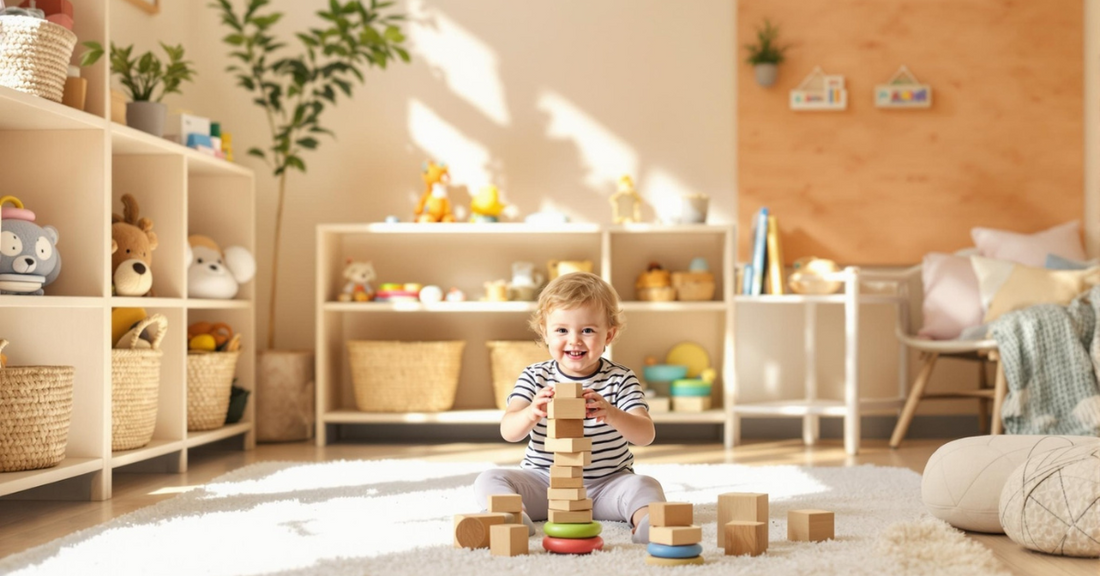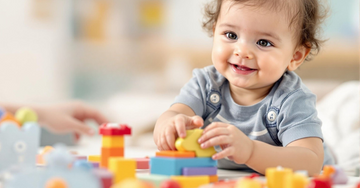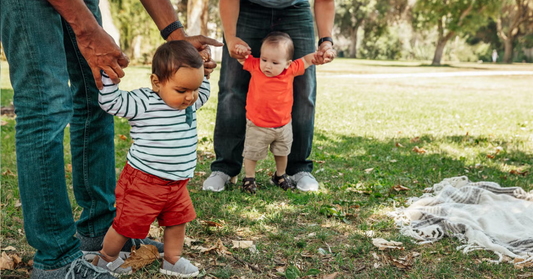Der ultimative Leitfaden zur Spielzeugrotation: Fokus fokussieren, Unordnung reduzieren und die Entwicklung verbessern

Entdecken Sie, wie Spielzeugrotation die Konzentration fördert, Unordnung reduziert und die Entwicklung Ihres Kindes fördert. Setzen Sie diese spannende Strategie für bewusstes Spielen noch heute um!
Helfen Sie Ihrem Kind, sich durch gezieltes Spielen zu entfalten

Bildbeschreibung: Ein fröhliches Spielzimmer mit ordentlich angeordneten Spielsachen auf Regalen und einem spielenden Kind.
Inhaltsverzeichnis
- Einführung in die Spielzeugrotation
- Die Wissenschaft hinter der Spielzeugrotation
- Planen Sie Ihr Spielzeugrotationssystem
- Spielzeugrotation implementieren: Schritt-für-Schritt-Anleitung
- Gemeinsame Herausforderungen meistern
- Maximierung des Entwicklungsnutzens
- Anpassung an verschiedene Altersgruppen und Situationen
- Nachhaltigkeit im Spielzeughandel
- Häufig gestellte Fragen
- Fazit: Beginnen Sie noch heute mit der Spielzeugrotation
Einführung in die Spielzeugrotation
Sind Sie überfordert von der endlosen Spielzeugflut in Ihrem Zuhause? Finden Sie, dass Ihr Kind trotz zahlreicher Spielsachen beim Spielen oft gelangweilt oder unkonzentriert wirkt? Dann könnte Spielzeugrotation die Lösung sein, nach der Sie gesucht haben.
Spielzeugrotation ist mehr als nur eine Aufräumaktion – sie ist ein durchdachter Ansatz, um das Spielerlebnis Ihres Kindes zu bereichern. Durch die gezielte Auswahl und den Austausch von Spielzeug schaffen Sie eine ansprechende Umgebung, die nicht nur Unordnung reduziert, sondern auch die Konzentration Ihres Kindes fördert, seine Kreativität fördert und seine Entwicklungsschritte unterstützt.
In diesem umfassenden Leitfaden gehen wir auf die wissenschaftlichen Grundlagen der Spielzeugrotation ein, zeigen Ihnen praktische Schritte zur Implementierung Ihres eigenen Systems und geben Tipps zur Bewältigung häufiger Herausforderungen. Egal, ob Sie frischgebackene Eltern sind oder Ihre bestehende Spielroutine auffrischen möchten – dieser Leitfaden gibt Ihnen die Werkzeuge an die Hand, um die Spielzeit einfach, sinnvoll und unterhaltsam zu gestalten.
Die Wissenschaft hinter der Spielzeugrotation
Kognitive Vorteile
Untersuchungen zeigen, dass eine große Menge an Spielzeug die Konzentrationsfähigkeit eines Kindes beeinträchtigen und es daran hindern kann, sich intensiv mit seinen Spielsachen zu beschäftigen. Eine Studie aus dem Jahr 2017, veröffentlicht in Verhalten und Entwicklung von Säuglingen fanden heraus, dass Kleinkinder, die weniger Spielzeug hatten, mit jedem Spielzeug länger und kreativer spielten. Durch die Einschränkung der Auswahlmöglichkeiten werden Kinder ermutigt, Spielzeug fantasievoller zu erkunden und zu nutzen, was ihre Problemlösungsfähigkeiten und ihre anhaltende Aufmerksamkeit verbessert.
Emotionale Regulierung
Ein Übermaß an Spielzeug kann zu Reizüberflutung, Stress und Wutanfällen führen. Die klinische Psychologin Dr. Laura Markham erklärt, dass vereinfachte Umgebungen Kindern helfen, sich sicherer zu fühlen und sich selbst zu beruhigen. Durch die Reduzierung der Spielzeuganzahl schaffen Sie einen beruhigenden Spielraum, in dem sich Ihr Kind auf eine Aktivität konzentrieren kann, was die emotionale Stabilität fördert.
Längere Spielzeuglebensdauer
Durch den Wechsel des Spielzeugs bleiben neue und spannende Dinge für sie spannend. Wenn ein Spielzeug nach einer Pause wieder eingeführt wird, kann es neues Interesse und Engagement wecken. Das maximiert nicht nur den Wert jedes Spielzeugs, sondern lehrt Kinder auch, ihre Sachen zu schätzen und darauf aufzupassen.
Elternbericht:
„Nachdem wir mit dem Spielzeugwechsel begonnen hatten, begann meine 9 Monate alte Tochter, ihre Spielsachen intensiver zu erkunden. Sie verbrachte fast eine Stunde damit, Becher zu stapeln und neue Spielmöglichkeiten zu entdecken. Es war eine Freude, sie so engagiert zu sehen!“
– Sarah, Mutter von zwei Kindern
Planen Sie Ihr Spielzeugrotationssystem
Die Erstellung eines effektiven Spielzeugrotationssystems erfordert sorgfältige Planung und Organisation.So können Sie beginnen:
Schritt 1: Spielzeuge nach Entwicklungsstadium kategorisieren
Es ist wichtig, die Entwicklungsbedürfnisse Ihres Kindes zu verstehen. Kategorisieren Sie Spielzeuge danach, welche Fähigkeiten sie in verschiedenen Altersstufen fördern.
Neugeborene (0–6 Monate):
- Sensorische Stimulation: Kontrastreiches Spielzeug und weiche Spiegel zur Entwicklung des Sehvermögens.
- Motorische Fähigkeiten: Weiche Rasseln und Greiflinge fördern die Handbewegungen.
Krabbelkinder (6–12 Monate):
- Erforschung: Knisterbücher und strukturierte Bälle regen den Tastsinn an.
- Ursache und Wirkung: Einfache Musikinstrumente oder Spielzeuge, die auf Aktionen reagieren.
Kleinkinder (1–3 Jahre):
- Problemlösung: Formsortierer und einfache Puzzles.
- Fantasievolles Spiel: Rollenspiel-Sets wie Spielzeugküchen oder Arztkoffer.
- Grobmotorische Fähigkeiten: Schiebe- und Ziehspielzeug und Aufsitzfahrzeuge.

Bildbeschreibung: Eine Tabelle mit Spielzeugkategorien für verschiedene Entwicklungsstufen und Bildern von Beispielspielzeugen.
Schritt 2: Erstellen Sie einen Rotationsplan
Ein einheitlicher Rotationsplan hilft, Abwechslung zu schaffen, ohne Ihr Kind zu überfordern. Hier eine allgemeine Richtlinie:
| Altersspanne | Rotationsfrequenz | Ideale Anzahl an Spielzeugen |
|---|---|---|
| 0–6 Monate | Alle 2–3 Wochen | 3–5 |
| 6–12 Monate | Alle 10–14 Tage | 5–7 |
| 1–3 Jahre | Wöchentlich | 6–8 |
Tipp: Passen Sie die Rotationen an die Entwicklungsmeilensteine an. Wenn Ihr Baby beispielsweise anfängt zu krabbeln, geben Sie ihm Spielzeug, das die Bewegung fördert, wie rollende Bälle oder weiche Stapelklötze.
Schritt 3: Organisieren Sie Ihre Speicherlösungen
Durch eine effektive Aufbewahrung bleibt das Rotationssystem übersichtlich und Ihr Raum aufgeräumt.
- Kleine Räume:
- Verwenden Sie durchsichtige, beschriftete Aufbewahrungsbehälter, die Sie unter dem Bett oder in Schränken verstauen können.
- Erwägen Sie vertikale Aufbewahrungslösungen wie Wandregale, um den Platz optimal zu nutzen.
- Größere Spielzimmer:
- Weisen Sie der aktuellen Spielzeugauswahl offene Regale zu.
- Verwenden Sie Aufbewahrungsschränke oder -behälter für Spielzeuge, die nicht im Wechsel verwendet werden.
- Unterwegs:
- Bereiten Sie für Ausflüge eine „Spieltasche“ mit ein paar Lieblingsspielzeugen vor, um auch unterwegs für Kontinuität zu sorgen.
Spielzeugrotation implementieren: Schritt-für-Schritt-Anleitung
Die Umsetzung Ihres Plans ist ein spannender Prozess. Befolgen Sie diese Schritte, um Ihr Spielzeugrotationssystem einzurichten:
Schritt 1: Führen Sie ein Spielzeug-Audit durch
Beginnen Sie damit, alle Spielsachen Ihres Kindes an einem Ort zu sammeln.
- Sicherheitscheck:
- Untersuchen Sie jedes Spielzeug auf Beschädigungen oder Abnutzung.
- Entsorgen Sie defekte oder sicherheitsgefährdende Gegenstände.
- Bewerten Sie die Entwicklungsrelevanz:
- Stellen Sie fest, ob jedes Spielzeug für das aktuelle Alter und die Interessen Ihres Kindes geeignet ist.
- Legen Sie Spielzeuge beiseite, die entweder zu anspruchsvoll oder nicht mehr fesselnd sind.
- Sentimentale Gegenstände:
- Erstellen Sie eine Erinnerungskiste für Spielzeuge mit besonderen Erinnerungen, die vielleicht nicht regelmäßig zum Einsatz kommen.
Schritt 2: Bauen Sie Ihre Spielzeugbibliothek auf
Ordnen Sie die restlichen Spielzeuge in Kategorien ein, um den Wechsel zu vereinfachen.
Zu berücksichtigende Kategorien:
- Sensorisches Spiel: Spielzeug, das die Sinne anregt, wie strukturierte Bälle, Musikinstrumente oder Sandkästen.
- Aktives Spielen: Gegenstände, die die Bewegung fördern, wie Bälle, Tunnel oder Aufsitzspielzeug.
- Ruhige Zeit: Puzzles, Bücher und Stofftiere für ruhigere Momente.
- Kreatives Spiel: Künstlerbedarf, Bauklötze und Verkleidungskleidung.
Durch die Gruppierung der Spielzeuge sorgen Sie in jedem Rotationszyklus für eine ausgewogene Abwechslung.
Schritt 3: Rotationen strategisch einführen
Bei der Einführung des Spielzeugwechsels ist es wichtig, den Übergang reibungslos zu gestalten, insbesondere wenn Ihr Kind daran gewöhnt ist, dass ihm alle Spielzeuge zur Verfügung stehen.
- Für Kleinkinder:
- Integrieren Sie neues Spielzeug nahtlos in den Tagesablauf. Legen Sie eine neue Rassel neben den Wickeltisch oder ein weiches Buch ins Kinderbett.
- Für Kleinkinder:
- Beziehen Sie sie in den Prozess ein. Lassen Sie sie bei der Auswahl der Spielsachen für die Woche mithelfen, um ihnen ein Gefühl von Kontrolle und Spannung zu geben.
- Verwenden Sie positive Sprache, wie etwa: „Lasst uns ein paar besondere Spielzeuge für diese Woche aussuchen!“
Schritt 4: Überwachen und anpassen
Beobachtung ist der Schlüssel zur Verfeinerung Ihres Rotationssystems.
- Track-Engagement:
- Achten Sie darauf, zu welchen Spielzeugen Ihr Kind tendiert und welche es weniger fesseln.
- Achten Sie darauf, wie lange sie mit jedem Spielzeug spielen und wie sie es verwenden.
- Anpassungen vornehmen:
- Wenn ein Spielzeug nach zwei Rotationen immer noch ignoriert wird, sollten Sie es für eine Weile wegräumen oder spenden.
- Stellen Sie neue Spielzeuge vor, die auf aufkommende Interessen oder Entwicklungsstadien abgestimmt sind.
Experteneinblick:
Wenn man Kindern erlaubt, bestimmte Spielzeuge zu „vermissen“, kann das ihre Wertschätzung für sie steigern, wenn sie zurückkommen. Das ist eine frühe Lektion in emotionaler Belastbarkeit und im Umgang mit verzögerter Belohnung.“
– Dr. Becky Kennedy, klinische Psychologin
Gemeinsame Herausforderungen meistern
Die Einführung eines Spielzeugrotationssystems kann einige Hürden mit sich bringen. So lösen Sie einige häufige Probleme:
Herausforderung 1: Überrotation
Problem: Ein zu häufiger Wechsel des Spielzeugs kann Ihr Kind überfordern und eine intensive Beschäftigung verhindern.
Lösung: Halten Sie sich an einen konsistenten, vorhersehbaren Zeitplan. Kontinuität hilft Ihrem Kind, zu wissen, was es erwartet, und gibt ihm ausreichend Zeit, jedes Spielzeug zu erkunden.
Herausforderung 2: Anhänglichkeit an Spielzeug
Problem: Ihr Kind wehrt sich, wenn Sie bestimmte Spielsachen wegräumen, was zu Frustration oder Wutanfällen führt.
Lösung: Beziehen Sie Ihr Kind in den Rotationsprozess ein. Lassen Sie es jede Woche ein oder zwei Spielzeuge auswählen, die bleiben. Das gibt ihm ein Gefühl der Kontrolle und respektiert seine Bindungen.
Herausforderung 3: Geschenke und neues Spielzeug verwalten
Problem: Eine Flut neuer Spielzeuge aufgrund von Geburtstagen oder Feiertagen kann Ihr Rotationssystem durcheinanderbringen.
Lösung: Richten Sie eine spezielle „Geschenkkiste“ ein und führen Sie nach und nach neue Spielzeuge ein. Erklären Sie Ihren Familienmitgliedern Ihr System und erklären Sie, wie Ihr Kind davon profitiert.
Szenario aus dem echten Leben:
Geschwisterdynamik:
„Mein Kleinkind ist verärgert, wenn ich Spielsachen wegräume, die sein älteres Geschwisterchen noch benutzt.“
Lösung:
- Richten Sie gemeinsame Spielzonen und individuelle Kisten ein. Kennzeichnen Sie die Kisten für jedes Kind mit Farben, damit die Spielsachen geordnet bleiben.
- Ermutigen Sie zum gemeinsamen Spielen mit bestimmten Spielzeugen, während Sie die einzelnen Lieblingsspielzeuge in getrennten Rotationen beibehalten.
Maximierung des Entwicklungsnutzens
Beim Spielzeugwechsel geht es nicht nur um Ordnung – es ist ein Instrument zur Unterstützung der allgemeinen Entwicklung Ihres Kindes.
Kognitive Entwicklung
Indem Sie Ihrem Kind eine begrenzte Auswahl an Spielzeugen zur Verfügung stellen, fördern Sie seine Konzentration und sein intensiveres Engagement.
- Verbesserter Fokus: Längere, ungestörte Spielsitzungen fördern die Konzentration.
- Problemlösungsfähigkeiten: Durch wiederholte Interaktionen mit Spielzeug können Kinder verschiedene Verwendungsmöglichkeiten und Lösungen erkunden und so die neuronalen Bahnen stärken.
Emotionales und soziales Wachstum
Der Wechsel der Spielzeuge kann bei der Emotionsregulierung und beim sozialen Lernen helfen.
- Verzögerte Befriedigung: Das Warten auf die Rückkehr des Lieblingsspielzeugs lehrt Geduld und Selbstbeherrschung.
- Kreativität und Vorstellungskraft: Wenn weniger Spielzeug vorhanden ist, erfinden Kinder oft neue Spiele und Verwendungsmöglichkeiten für das, was sie haben, was ihre Kreativität fördert.
Körperliche Entwicklung
Rotierende Spielzeuge, die körperliche Aktivität fördern, unterstützen die Entwicklung motorischer Fähigkeiten.
- Feinmotorik: Die regelmäßige Verwendung von Spielzeugen wie Bauklötzen oder Schnürspielzeug verbessert die Hand-Augen-Koordination.
- Grobmotorische Fähigkeiten: Die abwechselnde Einführung von Geräten wie Balance Boards oder Tunneln unterstützt das körperliche Wachstum und die Sicherheit bei der Bewegung.
Expertenzitat:
„Durch den Wechsel der Spielzeuge bleibt die Spielzeit sowohl neuartig als auch herausfordernd, was für die Stimulation der Gehirnentwicklung und die Aufrechterhaltung des Interesses eines Kindes von entscheidender Bedeutung ist.“
– Dr. Tina Payne Bryson, Co-Autorin von Das Kind mit dem ganzen Gehirn
Anpassung an verschiedene Altersgruppen und Situationen
Für Vorschulkinder (3–5 Jahre)
Wenn Kinder wachsen, entwickeln sich ihre Spielbedürfnisse.
- Komplexes Spielzeug einschließen:
- Fügen Sie Brettspiele, komplexere Puzzles und Wissenschaftsbaukästen hinzu, um kritisches Denken zu fördern.
- Kunst und Handwerk:
- Wechseln Sie zwischen verschiedenen Kunstmaterialien wie Farben, Ton oder Collagematerialien, um die Kreativität frisch zu halten.
Für Kinder mit besonderen Bedürfnissen
Passen Sie die Rotation an die individuellen Anforderungen Ihres Kindes an.
- Sensorische Überlegungen:
- Fügen Sie sensorisches Spielzeug wie Gewichtsdecken, Zappelwerkzeuge oder taktile Bücher hinzu.
- Rotationsfrequenz anpassen:
- Beobachten Sie Ihr Kind und passen Sie es entsprechend an, je nachdem, wie es auf Veränderungen reagiert. Manche Kinder profitieren möglicherweise von längeren Spielzeiten mit jedem Spielzeugset.
Für Familien mit begrenztem Platz
Maximieren Sie Ihren Platz, ohne Kompromisse bei der Vielfalt einzugehen.
- Multifunktionsmöbel:
- Verwenden Sie Möbel, die gleichzeitig als Aufbewahrungsort dienen, wie Ottomanen oder Bänke mit Fächern.
- Digitales Tracking:
- Nutzen Sie Apps oder Tabellen, um den Überblick über die Standorte und Rotationspläne der Spielzeuge zu behalten, wenn der Platz knapp ist.
Nachhaltigkeit im Spielzeughandel
Die Spielzeugrotation steht auf natürliche Weise im Einklang mit nachhaltigen Praktiken.
- Umweltfreundliches Spielzeug:
- Entscheiden Sie sich für Spielzeug aus nachhaltigen Materialien wie Holz oder Bio-Stoffen.
- Qualität vor Quantität:
- Investieren Sie in langlebiges, zeitloses Spielzeug, an dem Sie jahrelang Freude haben, und reduzieren Sie so die Abfallmenge.
- Spenden und Teilen:
- Spenden Sie nicht mehr benötigtes Spielzeug an wohltätige Organisationen oder tauschen Sie es mit anderen Familien, um seine Lebensdauer zu verlängern.

Bildbeschreibung: Umweltfreundliches Holzspielzeug, ordentlich auf einem Regal angeordnet.
Häufig gestellte Fragen
F1: Wie gehe ich mit digitalem Spielzeug oder Apps um?
Antwort: Obwohl es wichtig ist, die Bildschirmzeit gemäß den pädiatrischen Richtlinien zu begrenzen, kann digitales Spielzeug sinnvoll eingesetzt werden. Wechseln Sie Lern-Apps oder E-Books ab, genau wie physisches Spielzeug. Bieten Sie beispielsweise eine Woche lang eine Zeichen-App an und wechseln Sie dann zu einer interaktiven Erzähl-App.
F2: Mein Kind spielt nur mit einem Spielzeug. Ist das in Ordnung?
Antwort: Absolut. Wenn Ihr Kind sich intensiv mit einem bestimmten Spielzeug beschäftigt, ist das ein Zeichen für eine sinnvolle Lernerfahrung. Bieten Sie ihm weiterhin abwechselnd andere Spielzeuge an, lassen Sie Ihr Kind sich aber auf sein Lieblingsspielzeug konzentrieren, solange es sein Interesse weckt.
F3: Kann ich auch Bücher rotieren?
Antwort: Ja! Durch den Wechsel der Bücher bleibt die Vorlesestunde abwechslungsreich und kann die Lesefreude fördern. Bringen Sie neue Themen ein oder greifen Sie alte Lieblingsbücher wieder auf, um sie an die aktuellen Interessen Ihres Kindes anzupassen.
F4: Wie schaffe ich es, die Spielsachen mehrerer Kinder unterschiedlichen Alters auszutauschen?
Antwort: Erstellen Sie ein Hybridsystem mit gemeinsam genutztem und individuellem Spielzeug.
- Gemeinsam genutztes Spielzeug: Gegenstände wie Musikinstrumente, Bauklötze oder Spielgeräte für draußen, an denen alle Kinder gemeinsam Spaß haben können.
- Einzelne Behälter: Beschriften Sie für jedes Kind Kisten mit altersgerechtem Spielzeug und stellen Sie sicher, dass jedes Kind eine Auswahl hat, die seinen Entwicklungsbedürfnissen entspricht.
F5: Was ist, wenn sich mein Kind gegen das Spielzeugrotationssystem sträubt?
Antwort: Veränderungen können für manche Kinder eine Herausforderung sein. Kommunizieren Sie offen und beziehen Sie Ihr Kind in den Prozess ein. Betonen Sie die Freude am Entdecken neuer Spielzeuge und seien Sie geduldig, während sich Ihr Kind an die neue Situation gewöhnt.
Fazit: Beginnen Sie noch heute mit der Spielzeugrotation
Ein Spielzeugrotationssystem ist eine einfache und wirkungsvolle Möglichkeit, die Spielzeit Ihres Kindes zu verbessern und seine Entwicklung zu fördern. Durch die sorgfältige Auswahl und Anordnung von Spielzeug schaffen Sie eine Umgebung, die Konzentration, Kreativität und Freude fördert.
Denken Sie daran: Das Ziel besteht nicht darin, den Spaß zu verringern, sondern die Erfahrungen Ihres Kindes zu bereichern.Durch die Rotation der Spielzeuge können Sie eine anregende Spielumgebung schaffen, ohne Ihr Kind und sich selbst zu überfordern.
Ihr 7-Tage-Starterkit für die Spielzeugrotation
- Tag 1: Führen Sie eine Spielzeugprüfung durch
- Sammeln Sie alle Spielzeuge ein und prüfen Sie sie auf Sicherheit und Relevanz.
- Tag 2: Speicher organisieren und beschriften
- Bereiten Sie Lagerbehälter vor und beschriften Sie diese deutlich.
- Tag 3: Kuratieren Sie die erste Rotation
- Wählen Sie für den ersten Zyklus eine ausgewogene Mischung an Spielzeugen aus.
- Tag 4: Spielbereich einrichten
- Ordnen Sie die ausgewählten Spielzeuge einladend und zugänglich an.
- Tag 5: Stellen Sie Ihrem Kind das System vor
- Erklären Sie ihnen die neue Einrichtung und beziehen Sie sie in den Prozess ein.
- Tag 6: Beobachten und Notizen machen
- Beobachten Sie die Interaktionen Ihres Kindes und notieren Sie sich seine Vorlieben.
- Tag 7: Reflektieren und anpassen
- Nehmen Sie auf Grundlage Ihrer Beobachtungen alle erforderlichen Änderungen vor.
Quellen:
- Smith, A., & Jones, B. (2017). Der Einfluss der Spielzeugmenge auf das Spiel von Kleinkindern. Verhalten und Entwicklung von Säuglingen, 45, 150-160.
- Markham, L. (2020). Friedliche Eltern, glückliche Kinder. TarcherPerigee.
- Payne Bryson, T., & Siegel, DJ (2012). Das Kind mit dem ganzen Gehirn. Delacorte-Presse.
- Kennedy, B. (2021). Good Inside: Ein Leitfaden, um die Eltern zu werden, die Sie sein möchten. Harper-Welle.







0 Kommentare